Jellyfish move by pulsing their bell-shaped bodies, which propels them through the water. They do this by contracting the circular muscles in their bell and then relaxing them, causing a rhythmic movement. The tentacles surrounding their bodies are used to capture food and can also assist with propulsion.
The pulsing movement of jellyfish is not a very fast method of travel, but it allows them to cover large distances using minimal energy. In addition, the pulsing motion creates a flow of water over the tentacles, which helps to bring food to the jellyfish.
Want to learn more about how jellyfish move? This article investigates jellyfish movement and more.
Do Jellyfish Move on Their Own? Do They Move Fast or Slow?
Yes, jellyfish can move on their own, and their movement can be described as slow and pulsing. Therefore, they move slowly. Watch this video to see how they move.
The slow movement of jellyfish allows them to cover large distances with minimal energy expenditure.
It also creates a flow of water over the tentacles, which helps to bring food to the jellyfish. This method of movement is not fast, but it is efficient and allows jellyfish to conserve energy.
It’s also important to note that the movement of jellyfish is not entirely voluntary. They are at the mercy of ocean currents and can be carried along by the water flow.
However, they are capable of adjusting their movement to some extent by using their tentacles and bell to steer themselves.
How Do Jellyfish Move in The Water?
Jellyfish move through the water by contracting and relaxing their bell-shaped body, creating a rhythmic pulsing motion that propels them forward. This motion is created by the circular muscles in their bell contracting and then relaxing.
The movement of jellyfish is not fast, but it is an efficient way for them to conserve energy and cover large distances, as mentioned earlier.
Did you know? Some species of jellyfish can also swim toward the light or make adjustments in their movement by using their tentacles. ~ Seasky.org
How Do Jellyfish Move without Bones? The Special Body Parts that Help in Movement
Jellyfish move without bones through the use of their unique anatomy, specifically their bell-shaped body and tentacles.
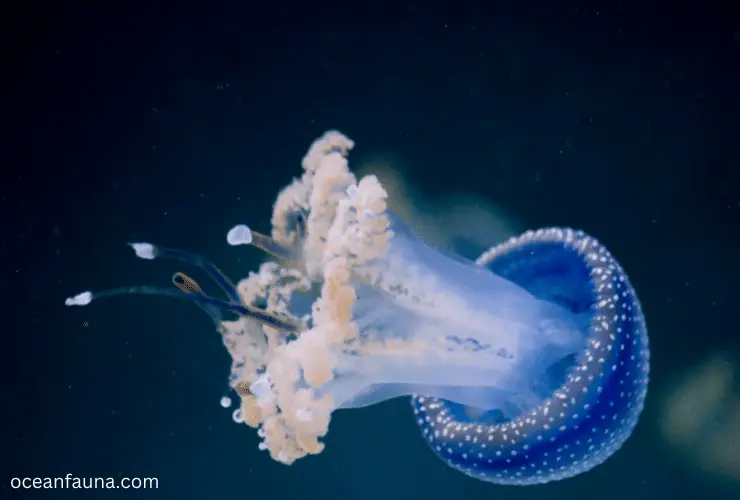
The jellyfish’s bell is made up of a thin, flexible material that allows it to contract and relax, creating a pulsing movement.
The circular muscles contract and relax, creating a pulsing movement that propels the jellyfish through the water.
In addition to the bell, jellyfish also have tentacles that allow them to move.
The tentacles are lined with stinging cells that are used to capture food. They can also create drag and help the jellyfish steer in the water.
Note: Jellyfish do not have a traditional skeleton. Instead, they have a structural support system in the form of a delicate network of fibers known as the mesoglea. This gives them their characteristic shape and provides support for the contractions and relaxations of the bell muscles. ~ National Geographic
Eye
Simple structure: Jellyfish eyes are simple in design, consisting of a single lens that focuses light onto a light-sensitive layer.
Purpose: The primary purpose of the jellyfish eye is to detect changes in light intensity, which helps the jellyfish navigate and avoid obstacles.
Nervous system
Simple Structure: Jellyfish have a simple nervous system consisting of a diffuse network of nerve fibers and nerve clusters known as nerve nets.
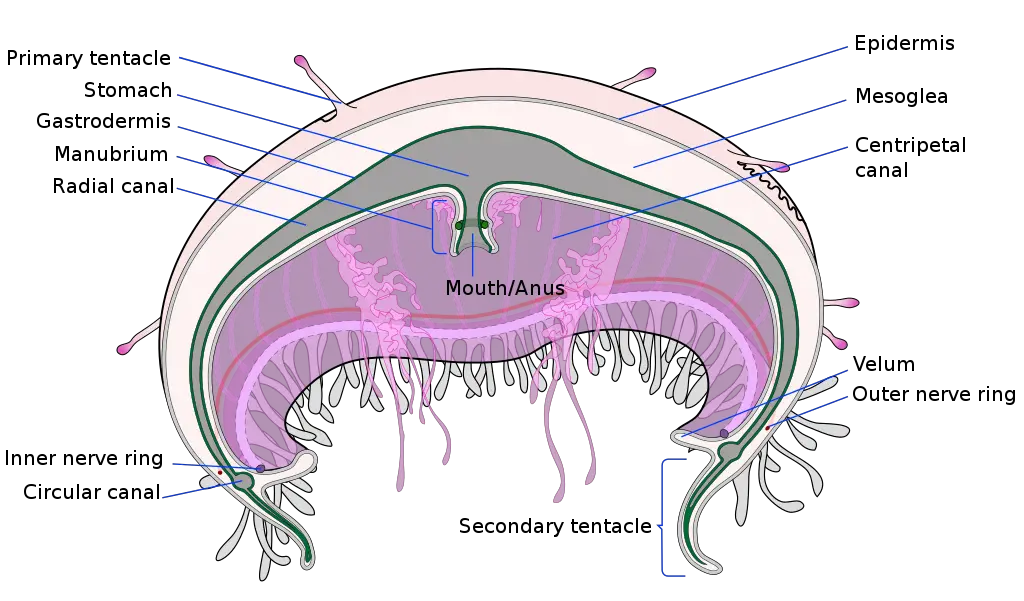
Coordination: The nerve nets help coordinate the movement of the jellyfish, allowing it to respond to stimuli such as touch, light, and changes in water flow.
Umbrella-shaped soft body
Structure: The umbrella-shaped soft body of a jellyfish is known as the bell.
It is composed of a thin, flexible material and is the main body structure that propels the jellyfish through the water.
Movement: The bell can contract and relax, creating a pulsing motion that propels the jellyfish through the water.
This pulsing movement is controlled by the circular muscles in the bell.
Radical muscles
Function: The radial muscles in a jellyfish are responsible for contracting and relaxing the bell, creating the pulsing movement that propels the jellyfish through the water.
Coordination: The radial muscles work in coordination with each other, creating a rhythmic pulsing motion that allows the jellyfish to move efficiently and conserve energy.
The coordinated contraction and relaxation of the radial muscles is a key component of the jellyfish’s unique movement.
Special feathery tendrils
Function: The special feathery tendrils of a jellyfish are used to capture food and steer the jellyfish in the water.
They are lined with stinging cells, which are used to immobilize prey and protect the jellyfish from predators.
Why Do Jellyfish Move?
Jellyfish move primarily for two reasons: to find food and to avoid predators. They use their umbrella-shaped bell to pulse through the water and steer toward areas where they can find food. ~ Source
At the same time, they use their feathery tendrils to sense and avoid potential danger, such as predators or obstacles.
The Process of Movement
The process of jellyfish movement involves the coordinated contraction and relaxation of its radial muscles in the bell.
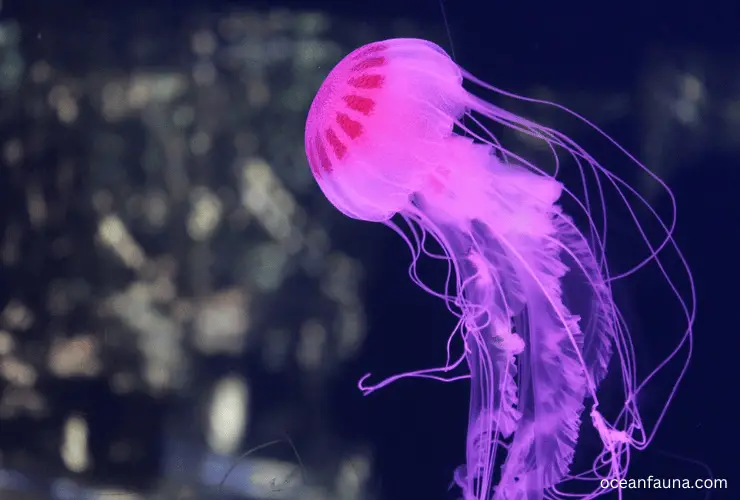
This pulsing motion propels the jellyfish through the water and helps it to steer and navigate.
Additionally, the feathery tendrils on the jellyfish create drag, helping in steering.
The combination of the pulsing bell and the movement of the tendrils allows the jellyfish to move efficiently and effectively in its aquatic environment.
Movement Through Exceptional Dance
Jellyfish move through an exceptional dance-like motion, using the coordinated contraction and relaxation of their radial muscles in the bell to pulse through the water.
This pulsing motion, along with the movement of their feathery tendrils, creates a graceful and efficient movement pattern.
The combination of the pulsing bell and the movement of the tendrils allows the jellyfish to move effectively in its aquatic environment while conserving energy. ~ Source
Why is Their Movement Attractive Compared to Others?
Jellyfish movement is considered attractive due to its graceful, fluid, and dance-like motion.
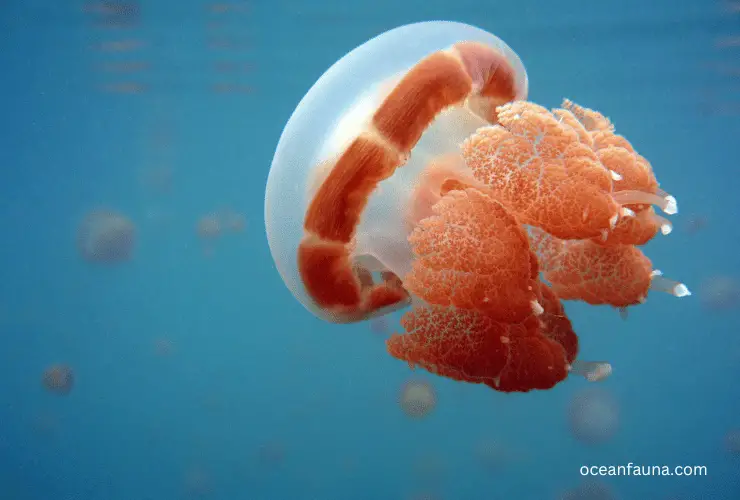
Their pulsing bell and feathery tendrils create a mesmerizing pattern of movement that sets them apart from other aquatic creatures.
The coordinated contraction and relaxation of the radial muscles in the jellyfish’s bell, combined with the movement of its tendrils, creates a unique and beautiful pattern of motion that many people find fascinating and attractive.
Why Do Jellyfish Like to Move in Groups?
Jellyfish often move in groups or “smacks,” for several reasons.
Group movement can provide safety in numbers, as the jellyfish are better able to detect and avoid predators when they are in a group.
Fun Fact: Moving in groups can also make it easier for the jellyfish to find food. ~ Source
Frequently Asked Questions (FAQs)
Can jellyfish move on land?
No, jellyfish cannot move on land as they are adapted to live in water and do not have any specialized structures for movement on land.
How do jellyfish move without a brain?
Jellyfish move without a brain through the coordinated contraction and relaxation of their radial muscles in the bell.
How do jellyfish move without muscles?
Jellyfish do not have any muscles and rely on the pulsing movement of their bell to move through the water.
How do jellyfish move their tentacles?
Jellyfish move their tentacles through coordinated contractions and relaxations of their radial muscles in the bell.
Final Thoughts
Jellyfish move through the coordinated contraction and relaxation of their radial muscles in the bell, creating a pulsing movement that allows them to move efficiently and effectively in the water.
They also use their feathery tendrils to assist in movement. While they do not have a brain or muscles in the traditional sense, their unique anatomy and movement patterns allow them to survive and thrive in their aquatic environment.
Their movement is considered attractive due to its fluid and dance-like motion, and they often move in groups for safety, food, and energy conservation.

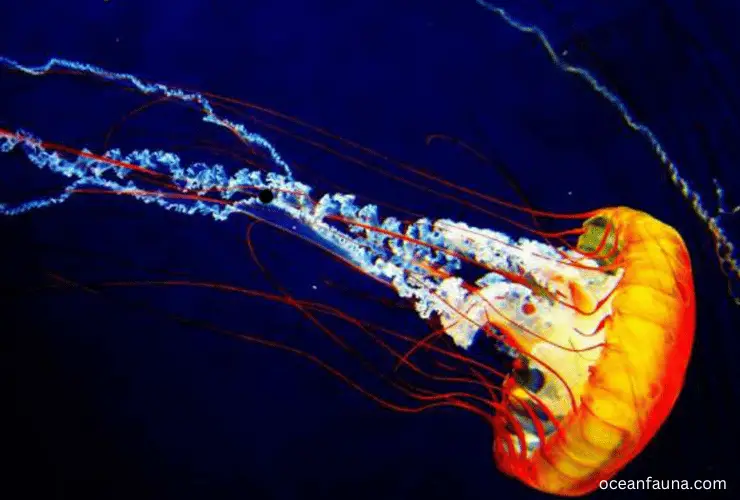
6 thoughts on “How Do Jellyfish Move? [Fascinating Reality]”